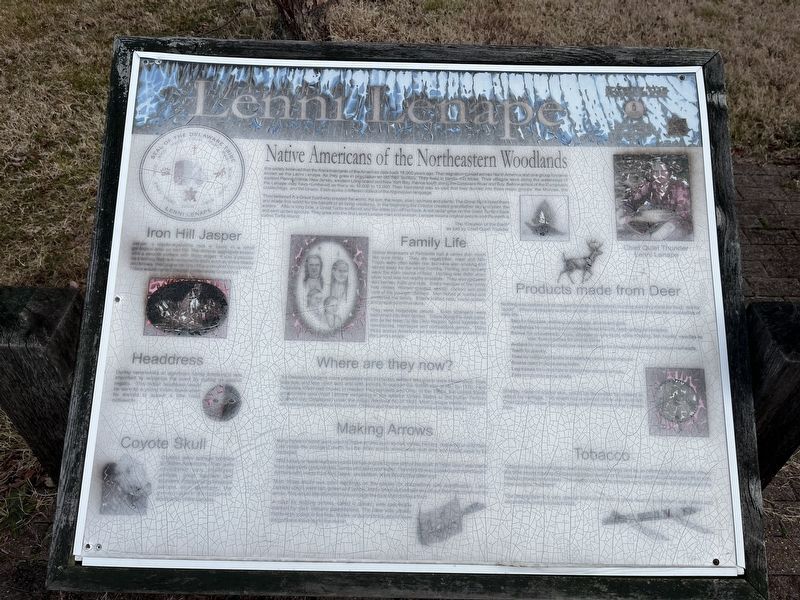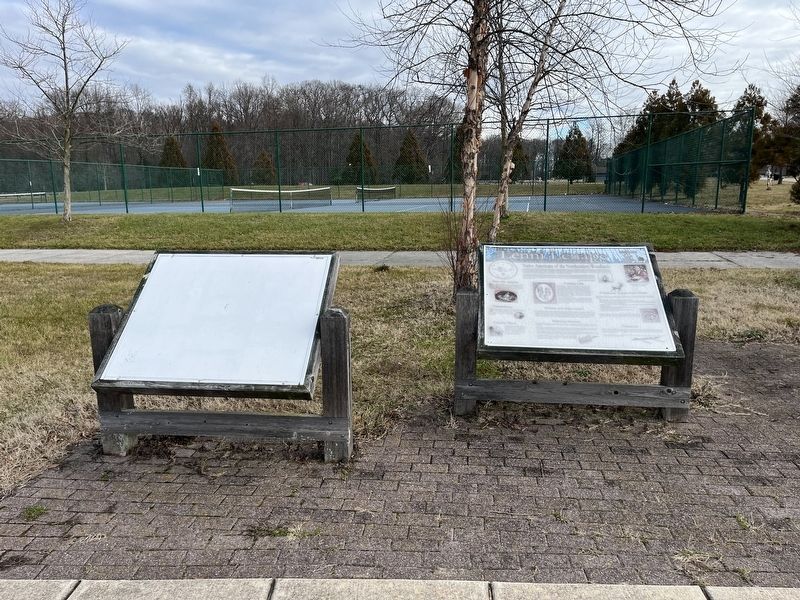Glasgow in New Castle County, Delaware — The American Northeast (Mid-Atlantic)
Lenni Lenape
Native Americans of the Northeastern Woodlands
It is widely believed that the first inhabitants of the Americas date back 15,000 years ago. That migration spread across North America and one group became known as the Lenni Lenape. As they grew in population so did their territory. They lived in bands and tribes. Their villages were along the waterways of eastern Pennsylvania, New Jersey, western Long Island and New York Bay, thence south along the Delaware River and Bay. Before arrival of the Europeans the Lenape may have numbered as many as 10,000 to 12,000. Their homeland was so vast that they divided into three major groups: the Munsee, the Unalachtigo, and the Unami. Each spoke a different dialect of the Algonquian language.
They believed in a Great Spirit who created the world, the sun, the moon, stars, animals and plants. The Great Spirit loved them and made this world for the benefit of all living creatures. In the beginning the Creator created grandfather sky and later, the waters. After a long time, a Great Turtle surfaced and the water ran off his back. A red cedar grew on the Great Turtle's back and sent up two sprouts. They grew into the first Lenni Lenape man and woman. Lenape means original people and the earth is called Turtle Island.
The "Creation of Earth" as told by Chief Quiet Thunder.
Iron Hill Jasper
Jasper, a crypto-crystalline rock is found in a small geological area on Iron Hill. The mineral aggregate breaks with a smooth surface with sharp edges. It was a popular rock among Native Americans for tools such as arrow heads and knives. Red jasper on Iron Hill is a result of iron content. Tribes would come many miles away to quarry it.
Headdress
During ceremonies of significant family functions it was important to recognize the event by putting on special regalia. This Indian headdress would be worn by a young Indian brave when he wanted to appear a little more noticeable.
Coyote Skill
Coyotes were spiritual brothers to Native Americans. They were considered very intelligent animals, great leaders and tricksters. Pressured by livestock owners, and farmers, the government sanctioned eradication of the coyotes.
Family Life
Native Americans of Pencader had a varied diet, much like ours today. They ate vegetables, meat and fish. Foods were often eaten raw, but were also smoked and stored away for the winter months. Fishing and farming were the main source of food. Hunting was done when other food was not readily available. They also gathered wild berries, fruits and nuts. Every member of the family had chores. Women planted, sewed, cooked and took care of the younger children. Men fished or
They were hospitable people. Even strangers were welcomed into their homes. Tribes around the east coast and as far away as the Ohio Region came together for ceremonies, marriages and competitive games. Many tribes across America can trace a common ancestor to the Lenni Lenape.
Where are they now?
As Delaware became more populated with European settlers and towns were established, there was less and less open land and wild animals to support the Indian way of life. By 1760, most Delaware tribes had moved to western Pennsylvania and Ohio. In the 1860s, the United States government sent most Lenape remaining in the eastern United States to the Indian Territory in present-day Oklahoma under the Indian Removal Act of 1830. Most Lenape reside there now with some communities in Wisconsin, Ontario and their ancestral homeland in New Jersey.
Make Arrows
Many types of wood were used to make arrows such as oak, cedar, hickory, dogwood, wild rose. Oak made the strongest shafts, but the other woods would warp over time and would need to be reshaped.
Wild turkey or hawk feathers would be tied or glued to one end of the shaft. This Glue was made from deer parts (ground toes, bones and skin) and water. The mixture was cooked until thickened.
Most tribes would use color markings on the arrow for decorations and identification. Lenni Lenape colors were red, green and yellow. Many times individuals would put their own mark on an arrow. This would identify which brave made the best bow during a hunt.
A case for holding arrows, called a caiver, was specifically marked for each owner's possessions. The case was usually made from a deer or fox hide. Marks, or decorations would have a significant meaning to the owner.
Products made from Deer
Nothing was wasted out of respect for all life and nature. Hunting was only done for food, not for "sport". When necessary to kill an animal, all parts of it were used to provide the necessities of daily life
Skin for blankets, clothing, bow strings, drums and glue.
Jawbones for removing corn (maize) from the cob, teeth acting as scrapers.
Bones for arrowheads, tools, whistles to lure birds while hunting, fish hooks, needles to sew, hole punches for animal skins.
Antlers for wands for medicine men and tools for shaping flaked stones into arrowheads.
Teeth for jewelry
Toes for rattles and ankle bracelets for ceremonial dances.
Brains used for processing hides.
Leg bones for wrenches to straighten warped arrows.
Fats to rub onto arrow shafts.
Shields, made of animal skin would be decorated by makers to reflect his heritage. This shield has a symbol of the clan to which Chief Quiet Thunder belongs along with the colors of the Lenape tribe.
Tobacco
Tobacco was a sacred plant used in many ceremonies and as an offering to the Creator. When the tribe would meet to discuss important events or decisions a calumet (peace pipe) filled with tobacco would be smoked. The smoke carried the prayers up to the Creator. All who shared the pipe became "brothers."
The peace pipe is a very special instrument with a great deal of symbolism with colors and decorations unique to each tribe.
Erected by Pencader Heritage Area Association.
Topics. This historical marker is listed in these topic lists: Anthropology & Archaeology • Native Americans. A significant historical year for this entry is 1760.
Location. 39° 36.5′ N, 75° 44.172′ W. Marker has been reported damaged. Marker is in Glasgow, Delaware, in New Castle County. Marker is on Pulaski Highway (U.S. 40) east of South College Avenue (Delaware Route 896), on the right when traveling west. Touch for map. Marker is in this post office area: Newark DE 19702, United States of America. Touch for directions.
Other nearby markers. At least 8 other markers are within walking distance of this location. Exploring the Past of Pencader Hundred (here, next to this marker); In the Beginning … (here, next to this marker); The March Through Pencader (here, next to this marker); The Battle of Cooch's Bridge (here, next to this marker); New Castle Frenchtown Railroad (a few steps from this marker); Historic Iron Ore Mining (approx. half a mile away); The Hundreds of Delaware (approx. half a mile away); a different marker also named Exploring the Past of Pencader Hundred (approx. half a mile away). Touch for a list and map of all markers in Glasgow.
Credits. This page was last revised on January 9, 2024. It was originally submitted on December 31, 2023, by Devry Becker Jones of Washington, District of Columbia. This page has been viewed 77 times since then and 54 times this year. Photos: 1, 2. submitted on December 31, 2023, by Devry Becker Jones of Washington, District of Columbia.

